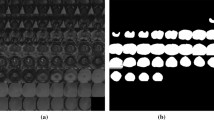Abstract
Accurate and appropriate prostate cancer detection can significantly reduce the death rate. In this research, the Henry Firefly Gas Solubility Optimization (HFGSO)-based Deep Residual Network (DRN) is established for the autonomous detection of prostate cancer. The pre-processing is done by Cuckoo Search-Based (T2FCS) filter and Type 2 Fuzzy. Subsequently, segmentation is exhibited by devised multi-objective SegNet scheme. The multi-objective SegNet method is newly designed by updating the objective function of SegNet with loss function. The multi-objective SegNet is trained by HFGSO. Then, data augmentation is done with cropping and rotation, which improves the performance of detection. At last, cancer identification is executed with DRN, and it is trained by HFGSO. The developed optimized multi-objective SegNet with DRN technique also achieved increased performance for the detection of cancer, with a sensitivity, specificity, and accuracy 0.9367, 0.9130, and 0.9263.









Similar content being viewed by others
Data Availability
The data underlying this article are available in Prostate MRI Dataset, “https://prostatemrimagedatabase.com/”.
References
Wang Y, Wang D, Geng N, Wang Y, Yin Y, Jin Y (2019) Stacking-based ensemble learning of decision trees for interpretable prostate cancer detection. Appl Soft Comput 77:188–204
Yoo S, Gujrathi I, Haider MA, Khalvati F (2019) Prostate cancer detection using deep convolutional neural networks. Sci Rep 9(1):1–10
Yu X, Lou B, Zhang D, Winkel D, Arrahmane N, Diallo M, Meng T, von Busch H, Grimm R, Kiefer B, Comaniciu D (2020) Deep attentive panoptic model for prostate cancer detection using biparametric MRI Scans, In: International Conference on Medical Image Computing and Computer-Assisted Intervention, Springer, Cham, pp 594–604
Cao R, Bajgiran AM, Mirak SA, Shakeri S, Zhong X, Enzmann D, Raman S, Sung K (2019) Joint prostate cancer detection and gleason score prediction in mp-MRI via FocalNet. IEEE Trans Med Imaging 38(11):2496–2506
De Vente C, Vos P, Hosseinzadeh M, Pluim J, Veta M (2020) Deep learning regression for prostate cancer detection and grading in bi-parametric MRI. IEEE Trans Biomed Eng 68(2):374–383
Xu H, Baxter JS, Akin O, Cantor-Rivera D (2019) Prostate cancer detection using residual networks. Int J Comput Assist Radiol Surg 14(10):1647–1650
Duran-Lopez L, Dominguez-Morales JP, Conde-Martin AF, Vicente-Diaz S, Linares-Barranco A (2020) PROMETEO: A CNN-Based Computer-Aided Diagnosis System for WSI Prostate Cancer Detection. IEEE Access 8:128613–128628
Lee W, Lenferink AT, Otto C, Offerhaus HL (2020) Classifying Raman spectra of extracellular vesicles based on convolutional neural networks for prostate cancer detection. J Raman Spectrosc 51(2):293–300
Arora S, Singh S (2013) The firefly optimization algorithm: convergence analysis and parameter selection. Int J Comput Appl 69(3):48–52
Iqbal S, Siddiqui GF, Rehman A, Hussain L, Saba T, Tariq U, Abbasi AA (2021) Prostate Cancer Detection Using Deep Learning and Traditional Techniques. IEEE Access 9:27085–27100
Yang XS (2009) Firefly algorithms for multimodal optimization. In: International symposium on stochastic algorithms. Springer, Berlin, Heidelberg, pp 169–178
Hashim FA, Houssein EH, Mabrouk MS, Al-Atabany W, Mirjalili S (2019) Henry gas solubility optimization: A novel physics-based algorithm. Futur Gener Comput Syst 101:646–667
Chen Z, Chen Y, Wu L, Cheng S, Lin P (2019) Deep residual network based fault detection and diagnosis of photovoltaic arrays using current-voltage curves and ambient conditions. Energy Convers Manag 198:111793
Kumar SV, Nagaraju C (2019) T2FCS filter: Type 2 fuzzy and cuckoo search-based filter design for image restoration. J Vis Commun Image Represent 58:619–641
Garber K (2010) A tale of two cells: discovering the origin of prostate cancer. J Natl Cancer Inst 102(20):1528–1535
Bray F, Ferlay J, Soerjomataram I, Siegel RL, Torre LA, Jemal A (2018) Global cancer statistics 2018: GLOBOCAN estimates of incidence and mortality worldwide for 36 cancers in 185 countries. CA Cancer J Clin 68(6):394–424
Siegel RL, Miller KD, Jemal A (2019) Cancer statistics. CA Cancer J Clin 69(1):7–34
Ahmed HU, Bosaily AES, Brown LC, Gabe R, Kaplan R, Parmar MK, Collaco-Moraes Y, Ward K, Hindley RG, Freeman A, Kirkham AP (2017) Diagnostic accuracy of multi-parametric MRI and TRUS biopsy in prostate cancer (PROMIS): a paired validating confirmatory study. Lancet 388(10071):815–822
Thestrup KCD, Logager V, Baslev I, Møller JM, Hansen RH, Thomsen HS (2016) Biparametric versus multiparametric MRI in the diagnosis of prostate cancer. Acta Radiol Open 5(8):2058460116663046
Stanzione A, Imbriaco M, Cocozza S, Fusco F, Rusconi G, Nappi C, Mirone V, Mangiapia F, Brunetti A, Ragozzino A, Longo N (2016) Biparametric 3T Magentic Resonance Imaging for prostatic cancer detection in a biopsy-naïve patient population: a further improvement of PI-RADS v2? Eur J Radiol 85(12):2269–2274
De Visschere P, Lumen N, Ost P, Decaestecker K, Pattyn E, Villeirs G (2017) Dynamic contrast-enhanced imaging has limited added value over T2-weighted imaging and diffusion-weighted imaging when using PI-RADSv2 for diagnosis of clinically significant prostate cancer in patients with elevated PSA. Clin Radiol 72(1):23–32
Greff K, Srivastava RK, Koutník J, Steunebrink BR, Schmidhuber J (2016) LSTM: A search space odyssey. IEEE Trans Neural Netw Learn Syst 28(10):2222–2232
Kuhl CK, Bruhn R, Krämer N, Nebelung S, Heidenreich A, Schrading S (2017) Abbreviated biparametric prostate MR imaging in men with elevated prostate-specific antigen. Radiology 285(2):493–505
Prostate MRI Dataset “https://prostatemrimagedatabase.com/”, accessed on January 2022
Badrinarayanan V, Kendall A, Cipolla R (2017) Segnet: A deep convolutional encoder-decoder architecture for image segmentation. IEEE Trans Pattern Anal Mach Intell 39(12):2481–2495
Zhang H, Hong X, Zhou S, Wang Q (2019) Infrared image segmentation for photovoltaic panels based on Res-UNet. In: proceedings of Chinese Conference on Pattern Recognition and Computer Vision (PRCV), pp 611–622
Renukalatha S, Suresh KV (2017) Automatic roi extraction in noisy medical images. ICTACT J Image Vid Process 7(4):1505–1514
Fernandis JR (2021) ALOA: Ant Lion Optimization Algorithm-based Deep Learning for Breast Cancer Classification. Multimed Res 4(1):105–116
Gokulkumari G (2020) Classification of Brain tumor using Manta Ray Foraging Optimization-based DeepCNN classifier. Multimed Res 3(4):32–42
Mohammed Ismail B, Alam M, Tahernezhadi M, Vege HK, Rajesh P (2020) A machine learning classification technique for predicting prostate cancer. In: Proceedings of the 2020 IEEE International Conference on Electro Information Technology (EIT), IEEE, Chicago, IL, USA
Hashim FA, Hussien AG (2022) Snake Optimizer: A novel meta-heuristic optimization algorithm. Knowl-Based Syst 242:108320
Singh D, Kaur M (2022) Evolving fusion-based visibility restoration model for hazy remote sensing images using dynamic differential evolution. IEEE Trans Geosci Remote Sens 60(1):1–14
Acknowledgements
I would like to express my very great appreciation to the co-authors of this manuscript for their valuable and constructive suggestions during the planning and development of this research work.
Funding
This research did not receive any specific funding.
Author information
Authors and Affiliations
Contributions
All authors have made substantial contributions to conception and design, revising the manuscript, and the final approval of the version to be published. Also, all authors agreed to be accountable for all aspects of the work in ensuring that questions related to the accuracy or integrity of any part of the work are appropriately investigated and resolved.
Corresponding author
Ethics declarations
Conflict of Interest
The authors declare no conflict of interest.
Informed consent
Not Applicable.
Ethical approval
Not Applicable.
Additional information
Publisher’s note
Springer Nature remains neutral with regard to jurisdictional claims in published maps and institutional affiliations.
Rights and permissions
Springer Nature or its licensor (e.g. a society or other partner) holds exclusive rights to this article under a publishing agreement with the author(s) or other rightsholder(s); author self-archiving of the accepted manuscript version of this article is solely governed by the terms of such publishing agreement and applicable law.
About this article
Cite this article
Reddy, S.K., Kathirvelu, K. Prostate cancer detection using Henry firefly gas solubility optimization-based deep residual network. Multimed Tools Appl 83, 29331–29352 (2024). https://doi.org/10.1007/s11042-023-16655-5
Received:
Revised:
Accepted:
Published:
Issue Date:
DOI: https://doi.org/10.1007/s11042-023-16655-5




